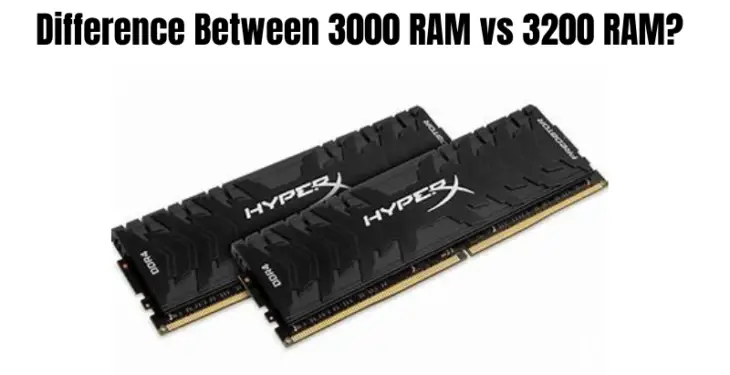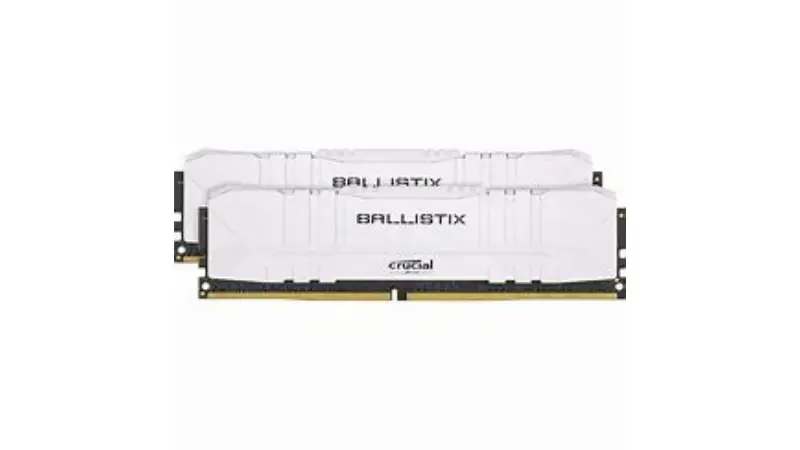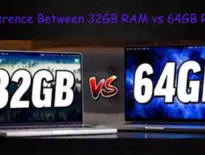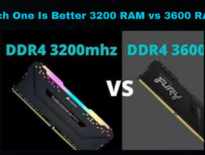Today, we’re going to take a look at two DDR4 memory kit speeds, 3000 RAM vs 3200 RAM. With only a 200 RAM difference in speed, there might not seem to be much difference. Whether you’re looking to get that all-important competitive edge or simply looking to improve your overall gaming experience, the right RAM speed is key. With so many options out there it can be hard to choose. We’re here to help.
The Specs of 3000 RAM vs 3200 RAM
The differences between 3000 RAM vs 3200 RAM are seen in the clock speed, bandwidth, and CAS latency. They are minute differences, especially in the latency with a difference of only 0.042 nanoseconds. However, they can have a reasonable impact on your gaming.
Read Article: Which One Is Better 3200 RAM vs 3600 RAM?
RAM Type
The major difference between 3000 RAM vs 3200 RAM is that the 3200 is available in (synchronous dynamic random-access memory) SDRAM while the 3000 is only available in (dynamic random-access memory) DRAM. SDRAM’s major improvement is the architecture of the memory. SDRAMs organize the memory into sections of equal size.
This allows each section to carry out tasks simultaneously. Rather than having to wait for one action or command to be completed before moving on to the next, these memory sections can pipeline. Pipelining is essentially preparing actions. This happens while the previous command is being carried out thus reducing the wait times.
The DDR4 3000 is a great choice for lighter gaming or multitasking. If you want to do some more serious gaming, you’ll want to go for a DDR4 3200. The SDRAM design will make things a lot smoother and quicker with RAM intensive apps and games.
Clock Speeds
RAM is measured by the number of cycles or operations it can carry out in a second. The MHz rating is a measure of how many mega transfers the stick can complete in a second. A single mega transfer is equivalent to 1,000,000 data transfers so a 3000mhz RAM stick can manage 3,000,000 data transfers in a second.
If we compare the 3000 with the 3200, we get a 6.6% increase in data transfer speeds with the 3200. Both the 3000 and 3200 will give you a good gaming experience but the 3200 edges out ahead thanks to that extra 200mhz. To be honest, the difference won’t be huge. You may not even notice it at this level.
It’s certainly not as noticeable as the jump between 2400mhz to 2800mhz. If the difference in cost is as minimal as the speed difference then go ahead and buy the 3200mhz. We’d say don’t break the bank for 3200mhz, the 3000mhz will do well enough. Don’t fall into the trap of thinking that higher speed means a better product. There are other things to consider as well.
Bandwidth
Bandwidth is responsible for transferring data smoothly. A RAM with higher bandwidth speeds will make your PC run faster and more smoothly. The DDR4 3000 has a bandwidth of PC4-24000 while the DDR4 3200 has a bandwidth of PC4-25600. The 24000 mb/s is great but the 25600 is just so much better. It can handle multiple processes smoothly.
The DDR4 3200 is perfect for handling online data transfers simultaneously. It has an extra bit of space and speed that makes it more efficient and capable. 1600mb/s is enough extra speed to reduce lag times noticeably.
Motherboard Compatibility
The DDR4-3000 is able to connect with a number of different Intel motherboards. It is suitable for use with the Intel series 100, 200, 300, and Intel X299. This gives you a decent range of options when pairing the RAM with motherboards. However, yet again, the DDR4-3200 edges out ahead.
As well as being compatible with the Intel series 100, 200, 300, and the X299, the 3200 is also compatible with the ADM 300, 400, and X570. If you prefer AMD systems, you’re going to need to go for the 3200. The 3000 will physically fit as both have 288 pins but it doesn’t have the technical capacity to integrate with AMD systems.
CAS Latency
There seems to be some confusion surrounding the relationship between latency and speed. Faster speeds do not necessarily correspond to better latency. The clock speed refers to how much data is transferred per second, but the latency is a measure of the delay between a command being issued and the command being followed.
The DDR4 – 3000 has a latency of 14-17 while the DDR4 – 3200 has a latency of 14-16. The lower the number the better the latency as the number refers to how many clock cycles there are between the command being issued and the memory actually being accessed. We can see that both RAMs have a lower range of 14 but the 3200 has a slightly reduced upper range of 16.
This means that even when performing at the poorer edge of the latency scale, the 3200 will perform better than the 3000. That being said, when performing at their peak, both RAMs will have a similar latency. As such, it doesn’t matter too much which RAM you choose.
Overall Performance
The first thing to note about the performance of these RAMs is power consumption. The 3000 works on around 1.2V while the 3200 requires 1.35V or 1.4V. Again, it’s a small difference but it will have a big difference over time. Both of these RAMs are considered low voltage options, so they won’t overly tax your power supply.
Being DDR4 their voltage needs are significantly lower than older RAM sticks which means that you have the option to overclock. Overclocking modifies the stock timings and voltages to achieve higher clock speeds. Not all RAM sticks will respond equally to overclocking, it’s all down to the silicon lottery.
Also, pushing your RAM too far can make your system unstable at best, or damage components at worst. Not to mention voiding your warranty. Another great thing about both RAM is that you can overclock the RAM speed to meet your needs. This is achieved by increasing the voltage slightly. The DDR4 – 3200 has the edge in terms of performance.
It just nips ahead in terms of speed, latency, and bandwidth. While the differences aren’t huge they do provide a slight boost to the overall performance, speed, and smoothness of your experience. Both clock speeds are ideal for gaming. They can handle most games, though the 3200 will create a better overall experience.
Both are pretty super-powered for basic and casual gaming. Their performance levels are more geared towards gamers aiming to set benchmark scores. The 3200, in particular, is designed for seamlessly smooth performance.
Pricing and Availability
Both the 3000 RAM vs 3200 RAM kits are readily available from a wide range of retailers and manufacturers. For the DDR4 3000, you can expect to pay between $30 and $150 depending on the amount of storage. In many cases, kits are sold in pairs of RAM sticks. So even when advertised as 16GB, the RAM supplied are actually 2 separate 8GB sticks of RAM.
One of the best values for money DDR4 3000 available right now is the Corsair Vengeance LPX. It has a clock speed of 3000mhz but it is designed for high speed overclocking. It uses aluminium heat spreaders to dissipate the heat generated by overclocking. This allows you to push it further than some other kits on the market.
Another excellent choice is the Patriot Memory Viper Series 4. It’s available in 8-32GB and can be overclocked to 3200mhz if necessary. One of the great things about these RAM sticks is that they are compatible with Ryzen and AMD motherboards. It’s ideal if you prefer Ryzen builds. Pricewise, the Patriot is comparable to the Corsair but it’s available with larger memory capacities.
To be totally honest, RAM prices are on the rise again after dropping in 2019. This probably has a lot to do with the current global situation and the increased demand as more people are forced to stay home. That being said, it hasn’t quite hit the sky-high prices of 2018. Looking at the DDR4 – 3200, again you have lots of brand and memory capacities available.
The 3200 does seem to be more readily available than the 3000. In fact, you need to read the product listing carefully when shopping for a 3000 as many 3200 RAM sticks appear. If we look at a direct comparison, the Corsair Vengeance LPX at 3200mhz is less than $10 more expensive. There seem to be some issues with overclocking this RAM stick.
Mainly due to the fact that some motherboards can’t deal with the increased speeds. So you do need to check carefully. If you’re after quick speeds, smooth performance, and an eye-catching design for your build, you should check out the Corsair Vengeance RGB Pro. Some users have registered speeds of up to 3600 mhz with appropriate motherboards.
If you want a real light show, go for the Adata XPG Spectrix D41 RGB DDR4 3200. It’ll give you nippy speeds, great cross-market compatibility, and the ability to customize the RGB lights to match your aesthetics. It’s slightly more expensive than the Corsair sticks, but that’s what you expect for the RGB lighting.
What Are The Major Differences Between 3000 RAM vs 3200 RAM?
Increased Transfer Speed
When you’re keen on achieving greater data transfer speed, 3200MHz RAM offer a wide advantage. Even if the difference may not be obvious for most tasks, it may prove useful later on.
Overclocking Potential
If you’re planning to select a processor with support for enhanced overclocking, 3200MHz RAM should be your choice. With the extra features from 3200MHz RAM, there’s an increased chance of smooth clocking through challenging tasks.
3000 RAM vs 3200 RAM Head To Head: Which RAM Stands Out
When it comes to overclocking speed, 3200MHz RAM has a slight edge over the 3200MHz. Also, the 3200MHz has a small difference when it comes to transfer speed, and processor
Between 3000 RAM vs 3200 RAM, Which Should You Select?
Your final choice should rest on the following.
- Current computing requirements (high-end gaming, graphics, general computing, etc.)
- Data transfer rates
- Compatibility with your motherboard
- Budget







